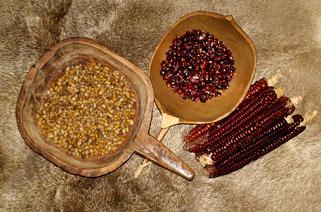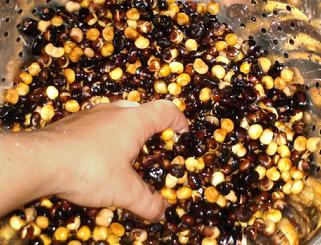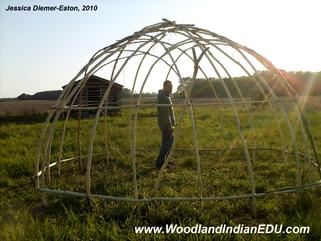 |
| Left to right: Delaware Blue, Miami Flour White, King Phillip Flint, and Longfellow Flint. |
|
|
 |
| King Phillip Flint corn (right) and dried hominy made of the same corn (left). |
|
|
 |
| Making hominy from Flint corn. You can see the shells (with color) separating, leaving the kernels yellow. |
|
|
I call it a tepee but they said it is a wigwam. What is the difference?
That is a pretty common question for both kids and adults. Thanks for asking.
Between the meanings of the words 'tepee' and 'wigwam' - not much. Each in its most general form translate to mean a home - just in different languages [tepee or tipi is a term of the Lakota-Sioux language (from the Plains, mid to western United States) that actually means to live, they (pl) or they live, which is then used to mean the home. Likewise, wigwam and all its similar terms (wikwam, wigasi, wigwasi, wikiup, etc.) is of another language family called Algonquian, and it too breaks down into parts, but generally refers to a home. The term wigwam is from the Algonquian language family of the Northeastern United States].
However, with that being said, it is appropriate in education settings, such as classrooms when we are learning about Native American Peoples, to use what we consider the correct terms to show the difference between a Native American home in the Plains or a Native American home in the Northeastern Woodlands.
The Tepee: Today, we use the term tepee to correctly define a home utilized by certain Native Peoples of the Plains, that was conical in shape, covered usually in animal hide (later canvas), and was able to pack down and move with its owners (frame poles and tepee cover), and be set-up in another location.
The Wigwam: We use the term wigwam to correctly define a type of home utilized by Native Peoples of the Northeastern Woodlands, that was oval, round, conical, or peaked in shape - and usually covered with bark and mats (made of reeds like cattails). Wigwams in the Northeastern United States were rarely covered with animal hides like tepees (and when they were, it was because of unusual circumstance, such as an example of Shawnee temporary wigwams covered in hides only because their actual wigwams were burned by an army in war). Unlike tepees, wigwams were not designed for moving. Many Northeastern Peoples lived in wigwams in permanent villages year round or most of the year. Wigwams, especially their frames, are permanent. For some who utilized wigwams for only certain times of the year, the coverings may be removed and brought back and reattached to wigwam frames as needed. In the far North, wigwams could be built in different locations with brought house coverings, but the framework never needed to travel.
|
Did they eat Indian corn or did they just make beads from it?
The Indian corn we use today for decoration is a mix of different Flint corns. Different varieties of Flint corns were usually grown separately by historic Native Peoples, which kept the colors separate. Most corn grown by the Woodland Indian People were yellow or white, while a few were blue (purple/black) and red. The decorative Indian corn was made multicolored by us for decoration.
Yes, they did eat the Flint corn. The decorative Indian corn is edible, but please do not eat it (as 1. you must know how to prepare it and 2. Indian corn is grown and sold for decorative use only, which means they might have been handled in a way that is not clean or chemicals may have been applied to it). The Native People of the Northeastern Woodland especially grew Flint corn to make cornmeal for puddings and breads, and hominy. Many Flint corns were grown by Woodland Indian People because they were the only corn variety that could be grown much more farther North were the growing seasons were shorter and the climate harsher. However, Flint corn was not the only type of corn they grew. They also grew and ate other varieties of corn (like Flour corns and Dent corns). All corn is Indian corn. Every type of corn we eat today come from the many varieties of corn grown originally by the Native American People.
While Flint corn kernels can be used for decoration, such as making beads from them, this is not the reason the Native American People grew this corn. There is very little evidence that Flint corn kernels served any purpose other than food. It is much more valuable as food. Beads could be made out of anything, and they did make beads of shell, bone, wood, stone, clay, and copper. They could paint them any color they wished with the pigments they made. There was no real want or value in wearing corn for decoration (unless it accompanied a particular ceremony that may have focused on corn or corn spirits).
|
 |
| A-Frame or Peaked Mat Covered Wigwam |
|
|
 |
| A-Frame Bark and Mat Covered Wigwam |
|
|
 |
| Round or Dome Shaped Wigwam |
|
|
 |
| The Wigwam Frame Is Permanent |
|
|
|